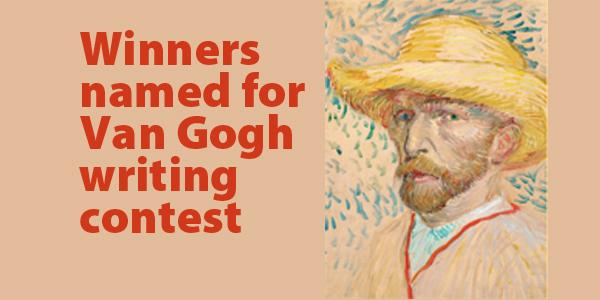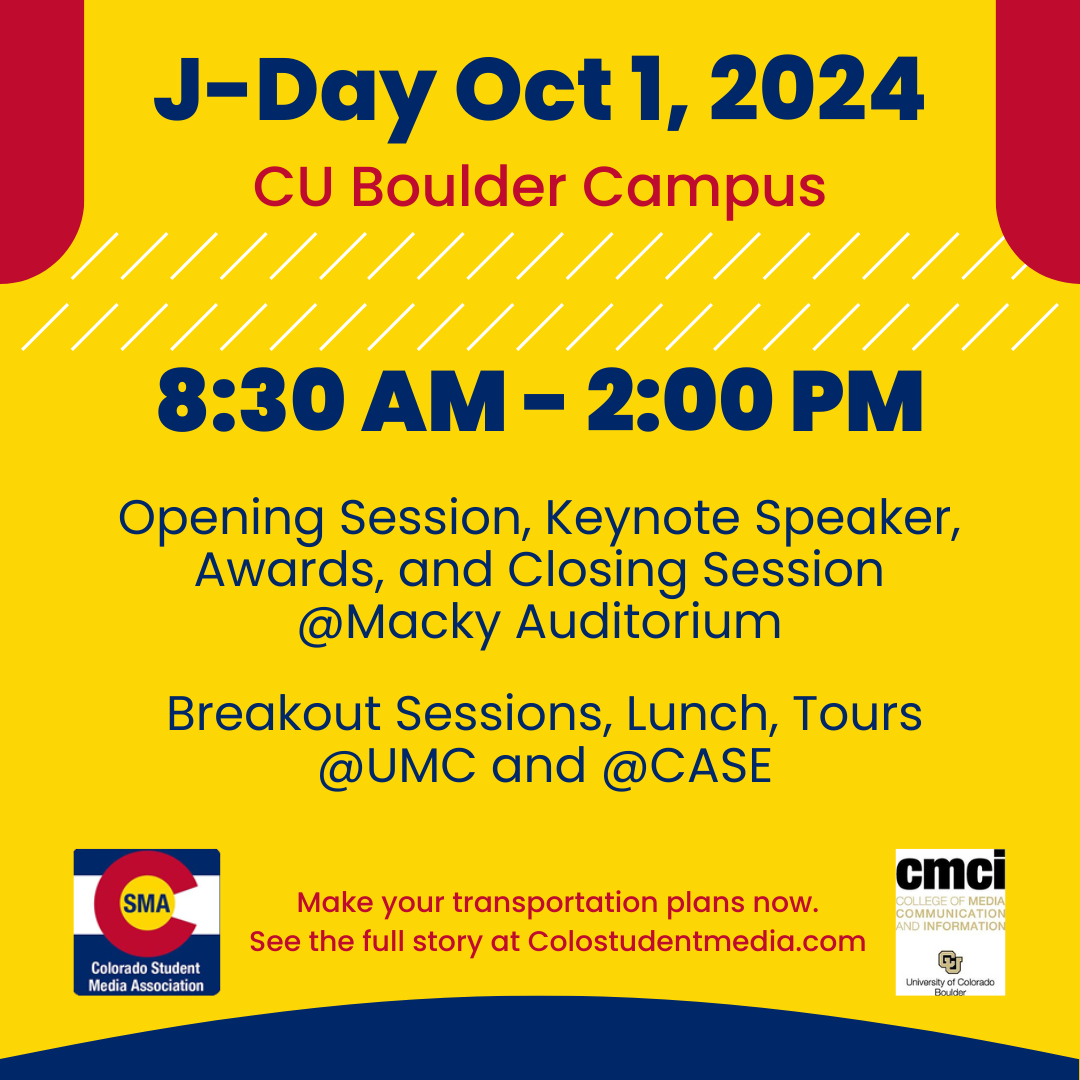One outcome of our latest partnership with the Denver Art Museum was an ad hoc writing contest, with students who attended the Oct. 18 Van Gogh Media Preview at the DAM entering either a review or a news story.
Kristin Bonk, the curatorial assistant for painting and sculpture reviewed the stories and had said, “Really, they’re pretty good! There’s a lot of fact-checking that they should take care of next time, but overall, very nice.”
The first place award goes to Emily Harmon and Sarah Greene, of the Grandview Chronicle. Their adviser is Catherine Sharp Moore. The writers will receive a Van Gogh t-shirt as well as passes to the exhibit.
Second place goes to Meredith Maney, of Littleton High School’s “The Lion’s Roar.” Her adviser is Kristin Kron. Meredith will receive passes the to Van Gogh exhibit.
The Van Gogh Media Preview was the third such event the DAM and CHSPA partnered on, and 17 students and 6 advisers took advantage of this opportunity to participate in a professional event, right along side local media. Look for another such opportunity in the spring of 2013.
The reviews honored are below:
FIRST PLACE – VAN GOGH WRITING CONTEST
Emily Harmon and Sarah Greene, Grandview Chronicle
Grandview High School, Review
The Rocky Balboa of Art
Even those who know very little about art recognize the painting. That self-portrait of the sandy-haired man, one eye blue, one eye green, peering at the viewer from beneath a straw hat.
We all know him as Van Gogh, the troubled artist who cut off his own ear. But that is not even one tenth of the story. The man behind “Starry Night” and “Sunflowers” was a self-taught artist, “the Rocky Balboa of art.” He was not afraid to completely revolutionize his style because, even though he struggled with depression, he put aside that dark, narrow place and changed how the world sees color.
“We’re taking the artistic journey of the artist and trying to downplay the biographical issues, we’re focusing on how people learn to look,” Gates Foundation curator of the Denver Art Museum’s “Becoming Van Gogh” Timothy Standring, said.
The Denver Art Museum recently acquired 85 pieces of art that illustrate Van Gogh’s artistic journey, approximately 70 created himself, and 15 painted by others that molded him into the artist the world recognizes today. The exhibit is not set up as a meaningless cluster of rooms filled with paint-splattered canvases, but flows like a book with seven chapters that tell the story of Van Gogh’s evolution as an artist. The exhibit showcases his personal voice, his artistic “handwriting” and displays his transition from the dull browns and grays of the Dutch period to the vivid colors of the French period.
The first object the viewer sees is a bright blue wall with a large painting of a cheery landscape depicting spinning windmills and wheat blowing in a breeze, the so-called “comfort food” Van Gogh that nearly everyone recognizes.
However, the next room, the first “chapter” of Vincent Van Gogh’s story, shows the viewer that he was indeed an artist that started “on a different foot,” in the words of Standring. Van Gogh was not born an artist. He had four careers in his lifetime which heavily influenced his style particularly in the beginning. Many of his first works from the Dutch period were painted in dark hues of brown and black and tend to be of mundane objects, a sharp contrast to his later works, most of which were landscapes. At the beginning of his career his pieces were very moral and sermon-like, a carry-over from his time as a pastor in Belgium.
“At the beginning, he had two left hands, he wasn’t very good at painting. He had to conquer it. He believed in what he was doing and so he devoted his whole life it. I think that’s the kind of fascination…Van Gogh has in general for the general public,” curator Louis Van Tilborgh said. Van Tulborgh is the senior researcher at Amsterdam’s Van Gogh museum and curator of “Becoming Van Gogh.”
In spite of his initial difficulties, Van Gogh found a method that worked for him. Although this early work has great value, eventually he decided he needed a change. So, he left the Netherlands for France, and in the space of a mere three years, he went from a blank face in a sea of thousands on a Paris street to the man who created art that touches people on a deeper level than what their eyes see. His art reaches out and grabs the viewer in a way that only the original works such as these have the power to do.
The DAM does not own any Van Goghs, Because of the “merits of the [exhibit’s] story-telling” patrons were compelled to contribute to the project, from a small museum in the north of England to international private collectors, more than 60 in all.
Standring made it clear that they were “loaning works of art, not money.”
“The times are over when you say the museums are doing this to get money,” DAM director Christoph Heinrich said.
So, why go? What would compel a museum to pour seven years of work into some pictures of a dead guy’s flowers? They are compelled by the fact that this exhibit is not just about flowers, or even about the artist.
As we walk through the rooms of the exhibit and observe how Van Gogh grew and changed as an artist, we find ourselves growing and changing, too. Leonardo Da Vinci once said that the artist’s job was to “translate beauty” to the rest of us. Without that beauty, we are no better than animals. The simplicity of Van Gogh’s work speaks across time, place and age.
We need to ensure beauty always has a place in our society — whether you are 18 or 87. As Blanche urges her sister Stella in Tennessee Williams’s Streetcar Named Desire, “don’t hang back with the brutes!” But the question still remains, Why go all the way to the museum to see Van Gogh when the Internet is a click away? By simply typing “Van Gogh” into Google, anyone can view his works.
But the experience of viewing the art through aching eyes trapped behind the bright glare of an 11X13 computer screen is vastly different from seeing the real paintings. In the museum, the original marks of his thick brush-strokes, the ink, reed and pen marks on the drawings are evident. Experiencing living, breathing art without the glare of a lifeless computer screen will only feed the eyes.
“Something happens to our core, like the way we respond to a poem, we respond to literature, we respond to the original work of art,” Standring said.
Standing in front of Van Gogh’s depiction of a cafe, one can almost hear the clamor of streets. Taste the sweetness of the fruit as the juice dribbles down one’s chin. Smell the flowers through the bright pastel meadow. Touch the rough wooden table the potato eaters huddle over. Feel the blisters from wearing a pair of old broken shoes.
And, of course, see all of these sensations because sight is the vehicle the other senses travel through.See the exhibit. Smell it. Taste it. Internalize the beauty around you and let the art remind you not only of your humanity, but that life is a richly textured, colored thing and it is waiting for you, just like it was for Van Gogh.
Remember the words of Van Tilborgh when he said, “Whether you’re eight or 18, you choose your path. And if you want to do something in life, do it with your whole heart and soul and put everything into it. And you might not have talent for certain things, even if you believe in it, but you have to try.”
#
RUNNER-UP – VAN GOGH WRITING CONTEST
Meredith Maney / Littleton High School
The Lions’ Roar / Review
For “Becoming Van Gogh,” it’s the journey, not the destination
Upon leaving “Becoming Van Gogh,” visitors are left with the quote, “And the great isn’t something accidental, it must be willed.”
It’s an idea “Becoming Van Gogh” embodies. The culmination of seven years of work by curators Timothy Standring and Louis van Tilborgh, the process of organizing an exhibit of such magnitude was a long time coming. Bringing in over seventy works from all across the world, Standring had been envisioning the exhibit since 1998.
“We respond to someone who is an underdog, a Rocky Balboa of art, who was determined and disciplined to become an artist… I identified with Van Gogh,” Standring said. And their connection is clear. Everywhere, carefully placed paintings compare Van Gogh to his contemporaries as he “reacts” to other artists. This exhibit is not made up of ‘Starry Night’ but rather the steps Van Gogh took to become that painter.
Standring said of the exhibit, “We start with the ‘comfort-food’ Van Gogh painting, the Van Gogh that we know, and then the Van Gogh we know less about, and that’s very brave; that’s why you put together exhibitions, because we are telling a different story.”
The story they weave is a fascinating one. It is not the same tragic story of Vincent Van Gogh students have been hearing since they were little; the story of the “Sunflowers” artist who cut off his ear and whose genius was never appreciated in his lifetime. Instead, the exhibit focuses on his influences, on his inspiration, on his journey. The time he spent in mental hospitals isn’t the story, it’s the footnote.
Through this, visitors have the opportunity to get to know a more real Van Gogh. He isn’t a yarn wielding, color loving, inherent genius, he’s a man who was down on his luck, but who found his footing as an artist.
“This is the first exhibit where you’ve got self portraits at the end [of the exhibit], and not at the beginning. We thought it would a nice way to round up the exhibition, because now you can have your own thoughts of this particular artist; you can project anything you want onto this man. You can have your own private moment with him.” van Tilborgh said.
“Becoming Van Gogh” does not have the ‘masterpieces.’ The paintings in the exhibit are not the famed ones that are known all around the world. While there are some pieces students might recognize from a textbook somewhere, such as ‘Portrait of the Postman Joseph Roulin,’ there is no piece that is definitively Van Gogh.
Yet the exhibit itself still manages to be a showcase of the true masterpiece: the power and perseverance of a man named Vincent, and how this utterly mortal man turned into an immortal artist named Van Gogh.
“Becoming Van Gogh” can be seen at the Denver Art Museum from October 21 to January 20. $13-$25. 720-865-5000 or denverartmuseum.org
#
















